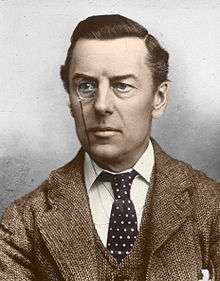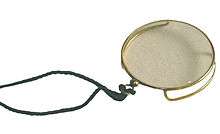Monocle
A monocle is a type of corrective lens used to correct or enhance the visual perception in only one eye. It consists of a circular lens, generally with a wire ring around the circumference that can be attached to a string or wire. The other end of the string is then connected to the wearer's clothing to avoid losing the monocle. The antiquarian Philipp von Stosch wore a monocle in Rome in the 1720s, in order to closely examine engravings and antique engraved gems, but the monocle did not become an article of gentlemen's apparel until the 19th century. It was introduced by the dandy's quizzing glass of the 1790s, as an article of high fashion.[1]
| Look up monocle in Wiktionary, the free dictionary. |

Styles

There are three additional styles of monocle. The first style consists of a simple loop of metal with a lens which was slotted into the eye orbit. These were the first monocles worn in England and could be found from the 1830s onwards. The second style, which was developed in the 1890s, was the most elaborate, consisting of a frame with a raised edge-like extension known as the gallery.[2] The gallery was designed to help secure the monocle in place by raising it out of the eye's orbit slightly, so that the eyelashes would not jar it. Monocles with galleries were often the most expensive. The wealthy would have the frames custom-made to fit their eye sockets. A sub-category of the galleried monocle was the "sprung gallery", where the gallery was replaced by an incomplete circle of flattened, ridged wire supported by three posts. The ends were pulled together, the monocle was placed in the eye orbit, and the ends released, causing the gallery to spring out and keep the monocle in place. The third style of monocle was frameless. This consisted of a cut piece of glass, with a serrated edge to provide a grip and sometimes a hole drilled into one side for a cord. Often the frameless monocle had no cord and would be worn freely. This style was popular at the beginning of the 20th century as the lens could be cut to fit any shape eye orbit inexpensively, without the cost of a customized frame.
Wearing a monocle is generally not uncomfortable. If customised, monocles could be worn securely with little effort. However, periodic adjustment is common for monocle wearers to keep the monocle from popping, as can be seen in films featuring Erich von Stroheim. Often only the rich could afford to have a monocle custom-fabricated, while the poor had to settle for ill-fitting monocles that were less comfortable and less secure. The popular perception was (and still is) that a monocle could easily fall off with the wrong facial expression. This is true to an extent, for example raising the eyebrow too far will allow the monocle to fall.

A once-standard comedic device exploits this: an upper-class gentleman affects a shocked expression in response to some event, and his monocle falls into his drink, or smashes to pieces on the floor, etc. Abraham Lincoln was not known to wear a monocle,[2] although it has also been said that he created his own style of monocle and wore it when he was away from the public.
The quizzing glass should not be confused with a monocle, since it is held to one's eye with a handle in a fashion similar to a lorgnette. A quizzing glass is not held by the eye socket itself.
Wearers
During the late 19th and early 20th centuries, the monocle was generally associated with wealthy upper-class men.[3][4] Combined with a morning coat and a top hat, the monocle completed the costume of the stereotypical 1890s capitalist. Monocles were also accessories of German military officers from this period; especially from World War I and World War II. German military officers known to have worn a monocle include Hans Krebs, Werner von Fritsch,[5] Erich Ludendorff,[6] Walter Model, Walter von Reichenau, Dietrich von Saucken, Hans von Seeckt,[7] and Hugo Sperrle.
Monocles were most prevalent in the late 19th century, but are rarely worn today. This is due in large part to advances in optometry which allow for better measurement of refractive error, so that glasses and contact lenses can be prescribed with different strengths in each eye.
The monocle did, however, gain a following in the stylish lesbian circles of the early 20th century, when lesbians would wear a monocle for effect. Such women included Una Lady Troubridge, Radclyffe Hall, and Weimar German reporter Sylvia von Harden; The painting Portrait of the Journalist Sylvia Von Harden by German expressionist painter Otto Dix depicts its subject wearing a monocle.
Famous figures who wore a monocle include British politicians Joseph Chamberlain, his son Austen, Henry Chaplin, and Angus Maude. Percy Toplis (The Monocled Mutineer), founder of Pakistan Mohammad Ali Jinnah, Portuguese President António de Spínola, filmmakers Fritz Lang and Erich von Stroheim, prominent 19th-century Portuguese writer Eça de Queiroz, Soviet writer Mikhail Bulgakov, actor Conrad Veidt, Dadaists Tristan Tzara and Raoul Hausmann, esotericist Julius Evola, French collaborationist politician Louis Darquier de Pellepoix, Poet laureate Alfred Lord Tennyson, singer Richard Tauber, diplomat Christopher Ewart-Biggs (a smoked-glass monocle, to disguise his glass eye), Major Johnnie Cradock, actors Ralph Lynn, George Arliss and Martyn Green, and Karl Marx. In another vein, G. E. M. Anscombe was one of only a few noted women who occasionally wore a monocle.[8] Famous wearers of the 21st century so far include astronomer Sir Patrick Moore, and former boxer Chris Eubank. Abstract expressionist painter Barnett Newman wore a monocle mainly for getting a closer look at artworks.[9] Richard Tauber wore a monocle to mask a squint in one eye.
In popular culture
Fictional characters that wear monocles include...
- Planters mascot Mr. Peanut
- Lord Peter Wimsey - Aristocratic 1920s sleuth
- The P. G. Wodehouse character Psmith
- Batman antagonist the Penguin
- Avengers antagonist and leader of HYDRA Baron Wolfgang Von Strucker
- Count von Count from the children's program Sesame Street
- The New Yorker mascot Eustace Tilley, an early 19th-century dandy, is depicted using a monocle like a quizzing glass.
- A monocle is also a distinctive part of the costume of at least three Gilbert & Sullivan characters: Major-General Stanley in The Pirates of Penzance; Sir Joseph Porter in H.M.S. Pinafore; Reginald Bunthorne in Patience; and Composer Sullivan. In some variant productions, numerous other characters wear the distinctive eyewear, and some noted performers of the "G&S" repertoire also have worn a monocle.
- The Doctor, played by William Hartnell
- Mr. Uppity from the Mr Men franchise
- Many of the works of Osamu Tezuka including Black Jack and Astro Boy
- Doctor Yorkshire Bell
- Pompadour from Babar
- Lord Scrappeton from Super Robot Monkey Team Hyperforce Go!
- The French gentleman thief Arsene Lupin is commonly said to have a monocle, and is illustrated with it on whenever not under a disguise.
- Charlie McCarthy, the famous dummy of Edgar Bergen, wore a monocle and was normally attired in formal wear.
- Werner Klemperer as Kommandant Wilhelm Klink in Hogan's Heroes
- Doc Savage aide 'Johnny' Littlejohn wore a monocle, as he was blind in one eye.
- The Calculus Affair and Tintin and the Picaros, Colonel Sponsz can be seen wearing a monocle.
- Momo Kawashima from the anime series Girls und Panzer wears a monocle akin to one half of a pair of glasses.
- Captain Good, a character in the book King Solomon's Mines, wore a monocle. Remote natives thought it was part of his eye, giving credence to his claim that he was a god.
- In the Mel Brooks' film Young Frankenstein, Inspector Kemp (portrayed by Kenneth Mars) absurdly wears a monocle over the eye patch that covers his left eye.[10]
- Sir Reginald Hargreeves from The Umbrella Academy, played by Colm Feore in the TV series of the same name
See also
- Glasses, traditional lens
- Pince-nez, glasses that grip the bridge of the nose
- Lorgnette, glasses that are held with a side-handle
- Monocular, a small hand held magnifying telescope
- Contact lens
References
- "Monocles". Spectacles Gallery. The College of Optometrists. Retrieved 19 March 2014.
- Ekstein, J.; Perkinks, J.; Perkinks, G. (1994). Gentlemen's Dress Accessories. U.K.: Shire Publications. ISBN 0-85263-904-X.
- Lowder, J. Bryan (27 December 2012). "The One-Eyed Man Is King". Slate. Retrieved 4 January 2014.
- Will Femia (19 September 2012). "Monocles: 'Ow, do people really wear these?'". MSNBC. Retrieved 4 January 2014.
- "Werner von Fritsch". schikelgruber.net. Archived from the original on 20 March 2012. Retrieved 4 September 2015.
- "Erich Ludendorff". mousely.com. Archived from the original on 27 July 2011. Retrieved 4 September 2015.
- "Hans von Seeckt". preussen-chronik.de. Retrieved 4 September 2015.
- O'Grady, Jane (11 January 2001). "Elizabeth Anscombe". The Guardian. London. Retrieved 13 May 2010.
- Schneider, Pierre (Summer 1969). "Through the Louvre with Barnett Newman". Artnews. 68 (4): 34–39, 70–72.
- "Inspector Kemp!" on YouTube
| Wikimedia Commons has media related to Monocles. |
.png)